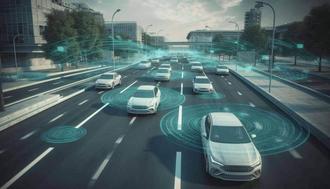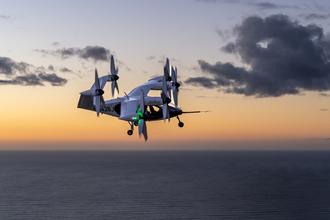High hopes for aerial mobility

Joby eVTOL Aircraft in flight. Photo Credit: © Joby Aviation
Wasted precious minutes in a traffic jam recently? You’re far from alone. In today’s often congested cities we seem to spend as much time sitting idle as moving. The problem is global. Drivers from Boston to Bogota, from Philadelphia to Paris, all lost the equivalent of days stuck in stationary queues in 2022. Londoners, citizens of the world’s most congested city, lost an extraordinary 156 hours to traffic delays last year, up 5% from pre-pandemic times.[1]

No wonder our eyes are turning to the skies – urban transport is no longer about vehicles clogging up roads. There is a new dimension of urban mobility that could soon revolutionize our cityscapes – aerial mobility.
Thanks to technological breakthroughs, for the first time in history we can realistically imagine a near-future scenario of goods – and people – being conveyed in the urban airways above our heads.
Air taxis and cargo drones can do more than save us time and money. With the true toll of urban pollution becoming ever more apparent, they can help decarbonize mobility, too. As confirmed at the COP28 climate summit in Dubai last year, 2023 was officially the warmest year on record, and we are all bearing witnesses to “climate collapse in real time”.[2] Fossil fuel use is being blamed for more than 5 million avoidable deaths annually.[3]
Against this stark backdrop, visionary modes of electrically-powered airborne transport have the potential to help keep alive the 1.5oC global warming scenarioand protect human health around the world. [4]
So, will we one day be carried away across the sky by aerial vehicles – or are we getting ‘carried away’ in another sense altogether, wooed by imaginative flights of fancy? The truth, as is so often the case, lies somewhere in between.
A high-flying market worth trillions
With the number of city dwellers tipped to increase from 4.4 billion presently to 6.7 billion by 2050[5], and private car ownership expected to remain popular, alternative mobility solutions are urgently needed.

A new generation of electric vertical take-off and landing (eVOTL) craft and unmanned aerial vehicles (UAVs) are ready to change everything we think we know about short-range transport. No longer will getting people or goods from A to B necessarily entail firing up an internal combustion engine. And even the most sustainably powered car or truck is of little use if it spends half the time stuck in traffic.
The new buzzwords are quiet, fast and clean.
The technology for electric flight is already upon us; all it requires is investment, legislative support and wide-scale rollout. Stakeholders should not struggle for motivation, given that the eVOTL market could be worth US$ 9 trillion by 2050[6] – surpassing the value of surface transport.
Helicopters already ferry the super-rich from meeting to meeting. UAVs and eVOTLs take this concept and run, or rather fly with it, promising to make airborne transit and logistics a reality for the masses.
How soon might they take flight and what might these cutting-edge vehicles look like?
Saving a billion people an hour a day

One such example is the multi-rotor VoloCity air taxi, designed by German aircraft manufacturer Volocopter, which could take to the skies as soon as 2024.
The two-seater VoloCity has conducted more than 2,000 test flights and won Design Organization Approval (DOA) for certification, environmental protection, and operational suitability.
Aside from the VoloCity, Volocopter is also working on two other eVOTL vehicles: The VoloRegion, a two/three passenger craft with 300-400 kg payload for traveling between cities and suburbs; and the VoloDrone, a heavy-lifting drone with 200 kg capacity and 40 km flight range, for transporting cargo. The three craft are united by VoloIQ, a digital platform used by customers for reserving flights.
Early models will still be flown by a pilot to comply with existing air regulations, but later iterations will phase out this component in favor of autonomous take-off, navigation and landing. With US$ 350 million raised in equity, VoloCity hopes to offer its service on both sides of the Atlantic. Paris and Los Angeles are early candidate cities, along with overcrowded conurbations across Asia.

Photo credit: © Lilium
Rival Lilium is deploying eVOTL technology on longer-range regional intercity transit. The first commercial flights on its electric jet could be offered as soon as 2024 in Florida, Brazil and Lilium’s home nation of Germany. Its five and seven-seater vehicles have a 280km range and are powered by a 1 MW lithium-ion battery.
Daniel Wiegand, Lilium CEO, predicts the industry will undergo exponential growth by 2030. By this time, he believes eVTOL aircraft “will become a part of everyday life”,[7] with cargo, taxi and sightseeing services regularly plying established intercity shuttle routes.
Lilium anticipates an initial price point of US$ 2.25 per passenger mile, becoming comparable cost-wise over time to high-speed trains or other earthbound transport options. It envisions a rapid turnstile-based boarding system, in sharp contrast to the wasted hours typically spent at conventional airports.
Meanwhile, the Jameel Investment Management Company (JIMCO) was an early investor in California-based Joby Aviation. Joby’s eVOTL craft seat four passengers plus a pilot and can reach speeds of 200mph.
It is the first such company certified for airworthiness by the US Air Force.

Photo credit: © Joby Aviation
The company anticipates a 2024 launch date for its air-taxi service.

Joby is targeting a mass-adoption strategy, aiming to “save a billion people an hour a day”[8]. This means not just helping business clients travel from one end of a city to another, but also conveying tourists to remote holiday spots, or providing aid relief to isolated locations hit by natural disasters.

Other companies vying to make an early impression in the electric aerial mobility market include Brazilian aerospace giant Embraer’s subsidiary Eve, French consortium Airbus’s CityAirbus NextGen program, and Israeli startup Urban Aeronautics.
Drones promise to deliver a less congested future?
It’s not just people that demand efficient, affordable movement from place to place. So too do the goods upon which we depend for home and office.
Road haulage via lorry, van or motorbike is slow, costly and damaging to the environment. We can and must do better.

Household deliveries and light freight are ripe for autonomous transport by air, as ecommerce giant Amazon has been quick to recognize. Its Amazon Prime Air service was unveiled in 2016 and subsequently trialed in Cambridge, UK.
From late 2024, Amazon customers in select locations in the UK, Italy and three US cities will have the option of drone delivery when finalizing their purchases.[9]
Amazon’s MK30 drone, quieter and lighter than its forebears, will operate from Same Day Delivery sites and carry packages up to 2.2kg in weight.
Amazon is not alone in pursuing the drone delivery dream. Irish company Manna has already commenced aerial deliveries of meals, groceries and coffee in Dublin, Ireland and Texas, USA.

The company is targeting 10 deliveries per hour, at least three times the delivery rate of a conventional scooter rider. With 150,000 delivery flights already successfully completed, Manna is now preparing for further expansion across Europe.[10]
Meanwhile, San Francisco-based Zipline is behind a range of small autonomous copters – or ‘zips’ – delivering blood to remote regions in Rwanda since 2016.
The drones ensure supplies regularly reach 350 medical centers in otherwise inaccessible locations. Three-quarters of blood deliveries outside the capital Kigali are now fulfilled by Zipline, cutting wait times from several days to 30 minutes.
Zipline has since spread throughout Africa, to Ghana, Côte d’Ivoire, Nigeria and Kenya, and since 2022 has also operated in Japan and the USA (Utah and Arkansas). Its drones have delivered almost 9 million items across more than 60 million miles, from industries including healthcare (prescriptions, vaccines and medicines), restaurants (fresh or processed foods), agriculture (livestock supplies) and groceries.
Overall, the number of packages delivered by drone reached almost 875,000 worldwide in 2022, a jump of more than 80% from the preceding year. Deliveries for 2023 are on track to cross the 1 million threshold for the first time.[11]

While the mass takeover of our skies by air taxis and unmanned delivery drones now seems likely, it is not yet inevitable – or at least not on the ambitious timeframes predicted by many. A considerable number of hurdles await us on our journey to an airborne future.
Could challenges ground aerial mobility dream?
From safety and noise to commercial readiness and infrastructure, the challenges awaiting a fledgling aerial mobility industry are substantial.
Chief among them is the availability of fast-turnaround vertiports. Passengers may be accustomed to long waits when flying from regular airports, but will expect a different experience from eVOTLs. To become truly indispensable, eVOTLs will require a comprehensive network of accessible take-off and landing sites conveniently embedded within urban locations.
Global business advisory firm McKinsey & Company proposes a trio of potential concepts for these departure zones:
- Vertihubs (purpose-built structures with a large number of arrival and departure pads along with retail outlets).
- Vertibases (new or existing buildings repurposed for eVOTL use, with at least three pads plus storage space).
- Vertipods (a single pad serving either a private facility or a remote rural location).

Whichever permutation is chosen, all bases will require high-speed charging equipment. Rapid charging facilities are already being developed for trucks and buses that could also charge drones enroute to a launch site – a concept known as ‘flash charging’. To minimize the cost of grid upgrades, electrical storage facilities at each landing hub could be charged slowly via normal power lines and then quickly discharged into the eVTOL’s batteries when needed. Meanwhile, dedicated solar panel clusters connected to eVTOL hubs could reduce the strain on the grid, putting carbon neutral air mobility within our reach.
Any city intent on modernizing human and cargo transit will need to create a legislative environment conducive to eVOTL vertiports. That will mean nurturing collaborations between public and private sectors to ensure their widespread and timely rollout.
With infrastructure logistics taking shape, other key challenges include:
- Safety: Unmanned aerial vehicles will need a large degree of autonomy once they outgrow the need for individual piloting. Suites of compact, ultra-lightweight sensors will be necessary to avoid drones colliding with buildings, pylons or – worst of all – manned aircraft mid-flight. In increasingly busy skies UAVs will require constant drone-to-drone communications over secure channels.
- Location / navigation: Current global positioning system (GPS) technology has significant limitations, with signals easily interrupted by the presence of tall buildings nearby. In an ecosystem supporting numerous drones from multiple operators, navigation is everything. Reliance on external signals must be replaced by robust internal navigation systems, using orientation and speed measurements to gauge precise locations.
- Noise: Noise pollution from road traffic and conventional flight paths is already a problem for city-dwellers – and a demonstrable cause of ill health. Will drones lose vital public support by adding to this unwanted cacophony? The noise emitted by UAVs comes from their high-speed rotating propellers. Yet cruising noise levels are negligible compared to traditional helicopters; Joby Aviation, for instance, recorded the equivalent of 45.2 A-weighted decibels (dBA) from its prototype craft at an altitude of 500 meters, barely distinguishable from other ambient noise at ground level.[12] Those living and working near vertiports, however, will be exposed to greater noise levels as drones gain and lose altitude. Further research is needed into noise abatement technology during take-off and landing.
- Software: Advanced air mobility solutions won’t run to scheduled services like conventional airlines. They will be booked at short notice, so operators must have the fleet capacity and agility to cope with fluctuating demand – to say nothing of a versatile, reliable and user-friendly app for customer use.
- Maintenance: eVOTL operators will need hangars near vertiports for both routine servicing and unplanned repairs, along with skilled engineers to carry out the work.
- Personnel: Autonomous drones licensed to carry people are some way off, so eVOTL operators could experience a severe pilot shortage as usage accelerates swiftly this decade. Modeling from McKinsey suggests the industry might require some 60,000 pilots by 2028, many of whom will eventually oversee flights from the ground. Some doubt whether the industry is doing enough to attract and train this new intake of pilots.
Efficiency is central to profitability. Estimates suggest a city hosting 85 to 100 landing pads must run around 10,000 trips daily (one departure per pad every five minutes at peak times) to bring per-mile costs down to a level comparable with other mass transport options.[13]
New batteries offer jolt to aerial mobility market
While a revolution quietly gathers pace in the skies above our cities, another revolution is taking place in research labs around the world – one which could bring the eVOTL vision a step closer to reality: Better batteries.
Calculations show that in order for eVOTLs to achieve economic feasibility, battery energy density will have to reach the 400 watt-hours per kilogram mark. Where are we at present? Current Tesla Model 3 batteries, for example, only clock in at 260 watt-hours per kilogram. However, a team at the National Institute for Material Science in Japan have designed 500 watt-hours per kilogram lithium-air batteries which could prove gamechangers – particularly if their efforts to optimize rechargeability and reliability also prove fruitful.[14]
As for package delivery drones, few will need to carry more than 2kg in weight – fortunate, given that battery size continues to dictate logistics.
One concept for more economical drone delivery revolves around a large van (replete with flash charging ports) conveying fleets of small drones to an improvised launch site equidistant from multiple delivery locations. Such ‘last-mile logistics’ is a huge market in waiting. In a recent survey in China almost three-quarters of respondents said they would pay a premium for faster delivery by drone.[15]
While heavy freight by autonomous drone remains decades away, Italian drone manufacturer FlyingBasket is trailing 100kg loads at distances up to 10km – transformational, if it proves commercially and technically feasible.
We are on the cusp of an exciting future, where the pressure building up within our historic road networks can slowly be vented into the ‘third dimension’ of airborne transit.
Realizing a new era of clean, rapid aerial logistics
Unmanned aerial vehicles and eVOTLs ae not just a dream for tomorrow but a reality for today. In America in 2021 there were already some 377,000 commercial drones registered with the Federal Aviation Administration – a rise of around 100,000 from just three years earlier.[16] In India, blighted by the world’s worst congestion issues, surveys suggests almost half of respondents would be willing to shift to air mobility for certain short-haul activities.[17]
The direction of travel, it seems, is up, up and away. Jia Xu, senior strategy director of American aerospace tech giant Honeywell, believes within a matter of years “it could be as normal to see parcels and passengers in urban airspace as it is to see birds and bees” and speculates whether we are on the cusp of a second “golden age of flight”.[18]
Even if that is the case, the transition is likely to be more gradual than optimists foresee. There remains, at present, a notable shortage of take-off and landing sites. The commercial viability and the physics of ultra-short flights are still coming into focus. Even if demand soars, a backlog of eVOTL orders is sure to limit their widespread rollout, and questions persist over the pipeline of qualified pilots. Plus, the industry must fight to overcome public safety perceptions, particularly given the plethora of alternatives for short-hop transit in urban environments. With comprehensive infrastructure already in place, trains, buses and trams have something of a head start as competition for passengers heats up.
As our highways become ever more congested, our imaginations might be tempted to soar away long before any mass fleet of air taxis is ready to take flight.
However, there exists a pathway to profitability which offers hope to those convinced that eVOTLs and unmanned drones are more than just a flight of fancy. Operators can seek to exploit ancillary forms of revenue such as retail services and app fees. Private companies might co-invest in landing zones near their corporate headquarters to improve efficiency and simultaneously raise their profiles. Public sector subsidies may become available for cities and states keen to improve public welfare or boost tourism. Utility companies and fuel providers might consider collaborations on infrastructure and charging hardware. And, in time, new leasing or revenue-share models will emerge to encourage the conversion of office and parking garage rooftops into vertipads using modular “infrastructure in a box” solutions.[19]
Indeed, driven by the resources of visionary investors like JIMCO, innovators in the aerial mobility space have every opportunity to solve the incumbent technological challenges and usher in a new era of clean, efficient and affordable airborne transport.
Things, dare we say it, are looking up.
[1] https://inrix.com/scorecard/
[2] https://www.bbc.co.uk/news/live/science-environment-67440257
[3] https://www.theguardian.com/environment/2023/nov/29/air-pollution-from-fossil-fuels-kills-5-million-people-a-year
[5] https://www.un.org/development/desa/en/news/social/urbanization-expanding-opportunities-but-deeper-divides.html
[6] https://assets.verticalmag.com/wp-content/uploads/2021/05/Morgan-Stanley-URBAN_20210506_0000.pdf
[7] https://www.mckinsey.com/industries/aerospace-and-defense/our-insights/speeding-up-everyday-travel-lilium-prepares-for-takeoff
[8] https://www.mckinsey.com/industries/aerospace-and-defense/our-insights/Rideshares-in-the-sky-by-2024-Joby-Aviation-bets-big-on-air-taxis
[9] https://www.aboutamazon.co.uk/news/operations/amazon-prime-air-drone-delivery-updates
[11] https://www.mckinsey.com/industries/aerospace-and-defense/our-insights/future-air-mobility-blog/commercial-drone-deliveries-are-demonstrating-continued-momentum-in-2023
[12] https://verticalmag.com/features/nasa-first-published-evtol-acoustic-test-data-set-stage-future/
[13] https://www.mckinsey.com/industries/automotive-and-assembly/our-insights/to-take-off-flying-vehicles-first-need-places-to-land
[14] https://www.sciencedaily.com/releases/2022/01/220120140724.html
[15] https://www.mckinsey.com/industries/aerospace-and-defense/our-insights/up-in-the-air-how-do-consumers-view-advanced-air-mobility
[16] https://www.forbes.com/sites/honeywell/2021/03/11/the-future-is-up-how-advanced-aerial-mobility-will-transform-transportation/?sh=41044042beb2
[17] https://www.mckinsey.com/industries/aerospace-and-defense/our-insights/up-in-the-air-how-do-consumers-view-advanced-air-mobility
[18] https://www.forbes.com/sites/honeywell/2021/03/11/the-future-is-up-how-advanced-aerial-mobility-will-transform-transportation/?sh=41044042beb2
[19] https://www.mckinsey.com/industries/automotive-and-assembly/our-insights/to-take-off-flying-vehicles-first-need-places-to-land





